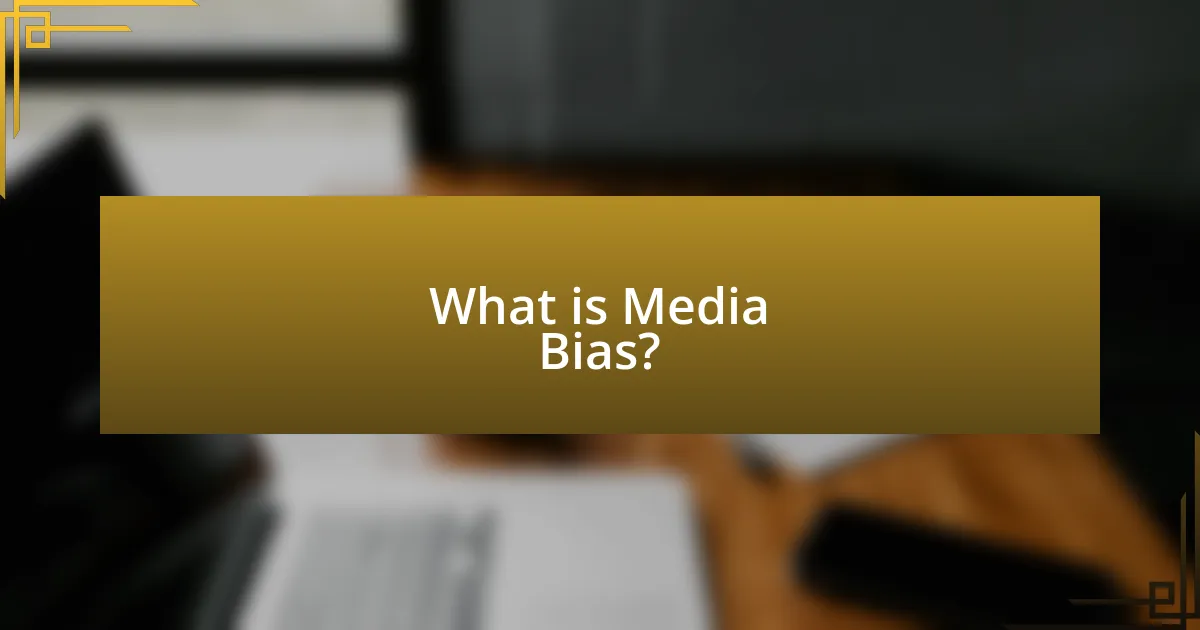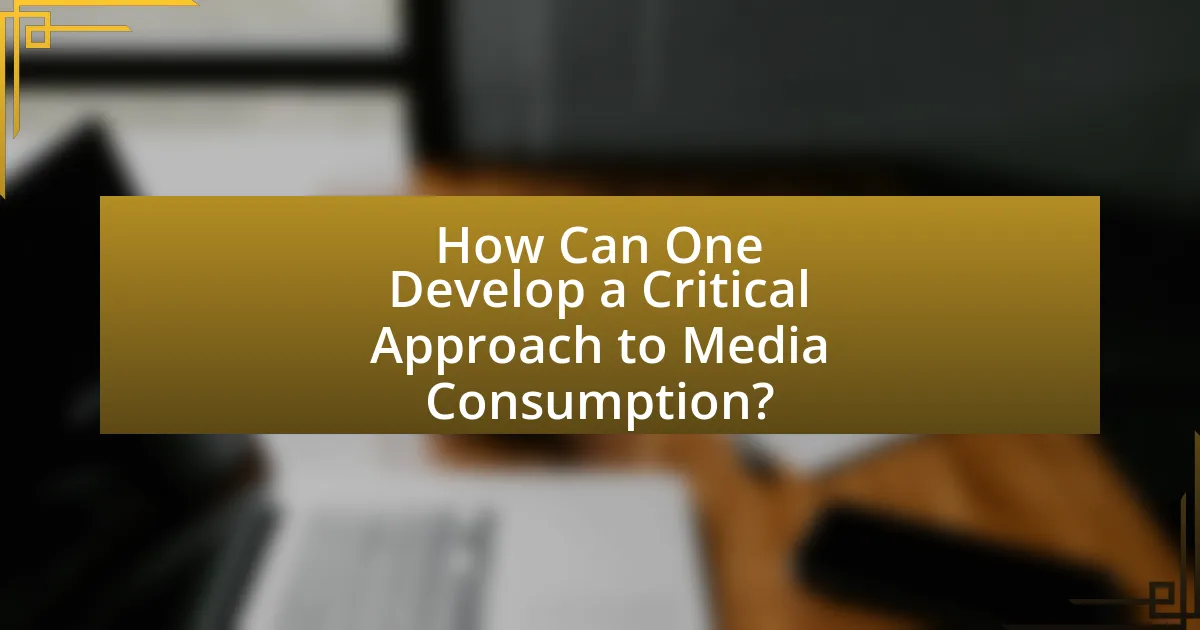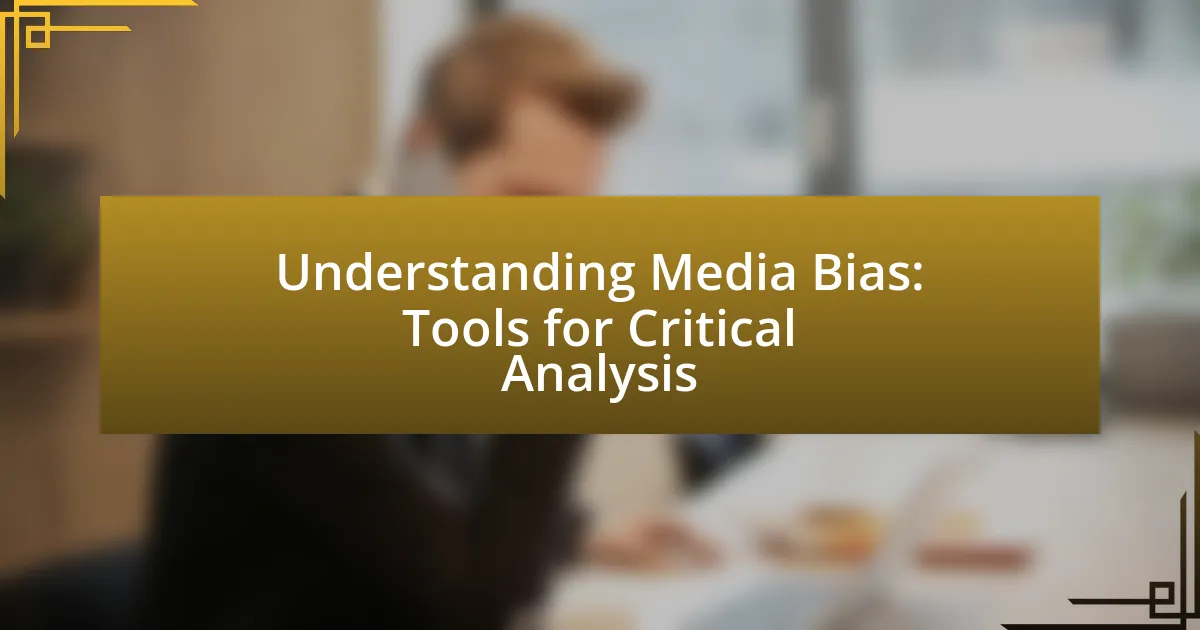Media bias refers to the perceived or actual partiality of journalists and news organizations in their reporting, influencing how news stories are presented and interpreted. This article explores the definition of media bias, its various types—including selection, framing, and confirmation bias—and how it manifests across different media formats. It emphasizes the importance of understanding media bias for informed decision-making and public opinion, highlighting tools and strategies for critical analysis, such as fact-checking organizations and media literacy programs. Additionally, the article discusses the role of media bias in democratic societies and offers practical tips for identifying and mitigating bias in news consumption.

What is Media Bias?
Media bias refers to the perceived or actual partiality of journalists and news organizations in their reporting, which can influence the presentation of news stories. This bias can manifest in various forms, such as selection of stories, framing of issues, and the language used, ultimately shaping public perception and opinion. Research indicates that media bias can significantly affect audience interpretation; for instance, a study by the Pew Research Center found that 62% of Americans believe news organizations tend to favor one side in their reporting.
How is Media Bias Defined?
Media bias is defined as the perceived or actual partiality of journalists and news organizations in their reporting, which can influence the presentation of news stories. This bias can manifest through selective reporting, framing, or the omission of facts, leading to a skewed representation of events or issues. Research indicates that media bias can significantly affect public perception and opinion, as studies show that audiences often interpret information through the lens of their own beliefs, reinforcing existing biases. For example, a 2018 study published in the journal “Political Communication” found that individuals exposed to biased news sources were more likely to hold polarized views on political issues.
What are the different types of Media Bias?
The different types of media bias include selection bias, framing bias, and confirmation bias. Selection bias occurs when certain stories or viewpoints are chosen over others, leading to an incomplete representation of events. Framing bias involves presenting information in a way that influences perception, such as emphasizing certain aspects while downplaying others. Confirmation bias happens when media outlets favor information that aligns with their existing beliefs, ignoring contradictory evidence. These biases can significantly affect public opinion and understanding of issues, as evidenced by studies showing that media framing can alter audience perceptions of political events and social issues.
How does Media Bias manifest in various media formats?
Media bias manifests in various media formats through selective reporting, framing, and language choices that influence audience perception. In print media, such as newspapers and magazines, bias can be evident in the choice of headlines, the prominence given to certain stories, and the language used to describe events or individuals. For example, a study by the Pew Research Center found that headlines can significantly shape public opinion by emphasizing specific aspects of a story while downplaying others. In broadcast media, such as television news, bias may appear in the selection of interview subjects, the tone of the reporting, and the visual imagery used, which can create a particular narrative. Online platforms, including social media, often exhibit bias through algorithm-driven content curation that favors sensational or polarizing viewpoints, as highlighted in research by the Oxford Internet Institute, which indicates that algorithms can reinforce existing biases by prioritizing engagement over balanced reporting. Overall, these manifestations of media bias across different formats can significantly impact public understanding and discourse.
Why is Understanding Media Bias Important?
Understanding media bias is important because it enables individuals to critically evaluate information sources and make informed decisions. Media bias can shape public perception and influence opinions by presenting information in a way that favors one perspective over another. For instance, studies have shown that biased reporting can lead to misinterpretations of events, as seen in the coverage of political elections where certain outlets may emphasize particular narratives that align with their ideological stance. Recognizing these biases allows consumers to seek diverse viewpoints, fostering a more comprehensive understanding of issues and reducing the risk of misinformation.
How does Media Bias influence public opinion?
Media bias significantly influences public opinion by shaping perceptions and beliefs through selective reporting and framing of information. When media outlets present news with a particular slant, they can affect how audiences interpret events and issues, often reinforcing existing biases or creating new ones. For instance, studies have shown that individuals exposed to biased media coverage are more likely to adopt the viewpoints presented, as evidenced by research from the Pew Research Center, which found that partisan media can lead to increased polarization among audiences. This demonstrates that the way information is presented can directly impact public attitudes and opinions on critical societal issues.
What role does Media Bias play in democratic societies?
Media bias plays a significant role in democratic societies by influencing public opinion and shaping political discourse. It affects how information is presented, often favoring particular viewpoints or political agendas, which can lead to polarization among the electorate. For instance, studies have shown that biased reporting can reinforce existing beliefs, as seen in the 2016 U.S. presidential election, where partisan media outlets contributed to the division of public opinion. This bias can undermine informed decision-making, as citizens may receive skewed information that does not represent a balanced view of issues.

What Tools Can Help Analyze Media Bias?
Several tools can help analyze media bias, including Media Bias/Fact Check, AllSides, and Ad Fontes Media. Media Bias/Fact Check provides a comprehensive database that rates the bias of various news sources based on their reporting patterns and factual accuracy. AllSides offers a platform that presents news stories from multiple perspectives, allowing users to compare how different outlets report the same events. Ad Fontes Media uses a unique rating system to classify news sources along a spectrum of political bias and reliability, helping users identify the slant of the information presented. These tools are widely recognized for their effectiveness in promoting critical analysis of media content.
How can Critical Thinking Skills be applied to Media Analysis?
Critical thinking skills can be applied to media analysis by enabling individuals to evaluate the credibility, bias, and intent of media sources. This involves systematically questioning the information presented, assessing the evidence provided, and identifying underlying assumptions or biases that may influence the portrayal of events. For instance, a study by the Pew Research Center found that individuals who engage in critical thinking are more adept at recognizing biased reporting and distinguishing between fact and opinion in news articles. By applying these skills, analysts can better understand the motivations behind media narratives and make informed judgments about the reliability of the information they consume.
What are the key critical thinking strategies for evaluating media?
Key critical thinking strategies for evaluating media include analyzing the source, assessing the evidence, identifying bias, and considering the context. Analyzing the source involves checking the credibility and expertise of the publisher or author, which can reveal potential biases or agendas. Assessing the evidence requires examining the data, statistics, and references provided to support claims, ensuring they are reliable and relevant. Identifying bias involves recognizing language, tone, and framing that may skew the information presented, while considering the context entails understanding the broader social, political, and economic factors that influence media narratives. These strategies are essential for discerning the accuracy and reliability of media content.
How can biases in reasoning affect media interpretation?
Biases in reasoning can significantly distort media interpretation by leading individuals to favor information that aligns with their pre-existing beliefs while disregarding contradictory evidence. This selective perception can result in a skewed understanding of news events, as individuals may interpret facts through a biased lens, ultimately shaping public opinion and discourse. For instance, research by the Pew Research Center indicates that individuals with strong political affiliations are more likely to consume media that reinforces their views, which can create echo chambers and limit exposure to diverse perspectives. Such biases not only affect personal interpretations but can also influence broader societal narratives, as media outlets may cater to these biases to attract specific audiences.
What Resources are Available for Identifying Media Bias?
Resources available for identifying media bias include media bias rating websites, fact-checking organizations, and academic research tools. Websites like Media Bias/Fact Check provide detailed analyses of various news outlets, categorizing them based on their political leanings and reliability. Fact-checking organizations such as Snopes and PolitiFact assess the accuracy of claims made in the media, helping users discern factual information from misinformation. Additionally, academic tools like the Pew Research Center offer studies and reports on media consumption and bias trends, providing empirical data that supports critical analysis of media sources.
Which websites and tools are effective for analyzing news sources?
Effective websites and tools for analyzing news sources include Media Bias/Fact Check, AllSides, and FactCheck.org. Media Bias/Fact Check provides detailed assessments of news outlets’ biases and factual accuracy, categorizing them on a spectrum from left to right. AllSides offers a similar service, presenting news stories from multiple perspectives to highlight bias. FactCheck.org focuses on verifying claims made in the media and by public figures, providing evidence-based assessments. These platforms are widely recognized for their reliability in evaluating media credibility and bias, making them essential resources for critical analysis of news sources.
How can fact-checking organizations assist in identifying bias?
Fact-checking organizations assist in identifying bias by systematically evaluating claims made in media and public discourse for accuracy and impartiality. These organizations employ trained analysts who scrutinize sources, context, and the framing of information, which helps reveal potential biases in reporting. For instance, the Poynter Institute’s fact-checking initiative has demonstrated that rigorous fact-checking can expose misleading narratives by providing evidence-based assessments of statements made by public figures and media outlets. This process not only highlights discrepancies but also educates the public on recognizing biased language and selective reporting, thereby fostering a more informed audience.

How Can One Develop a Critical Approach to Media Consumption?
To develop a critical approach to media consumption, individuals should actively analyze the sources, content, and context of the media they engage with. This involves questioning the credibility of the source, identifying potential biases, and understanding the motivations behind the information presented. Research indicates that media literacy programs, which teach skills such as source evaluation and fact-checking, significantly enhance critical thinking regarding media consumption. For instance, a study by the Stanford History Education Group found that students who received media literacy training were better at discerning credible information from misinformation.
What Strategies Can Enhance Media Literacy?
Strategies that can enhance media literacy include critical thinking exercises, media analysis frameworks, and educational programs focused on digital literacy. Critical thinking exercises encourage individuals to question the credibility of sources and the intent behind media messages. Media analysis frameworks, such as the CRAAP test (Currency, Relevance, Authority, Accuracy, Purpose), provide structured methods for evaluating information. Educational programs, like those implemented by organizations such as the News Literacy Project, teach skills necessary to discern fact from opinion and recognize bias in reporting. These strategies collectively empower individuals to navigate media landscapes more effectively, fostering informed decision-making and reducing susceptibility to misinformation.
How can one differentiate between opinion and fact in media?
One can differentiate between opinion and fact in media by evaluating the language used and the presence of verifiable evidence. Facts are statements that can be proven true or false through objective data, such as statistics or documented events, while opinions are subjective interpretations or beliefs that reflect personal views. For example, a news report stating that “unemployment rates decreased by 2% last year” is a fact, as it can be verified through labor statistics. Conversely, a statement like “the government is doing a poor job managing the economy” reflects an opinion, as it is based on personal judgment rather than objective evidence. Recognizing these distinctions is crucial for critical analysis of media content.
What questions should be asked when consuming news content?
When consuming news content, individuals should ask the following questions: Who is the source of the news? Understanding the source helps assess credibility. What is the purpose of the news? Identifying whether the intent is to inform, persuade, or entertain can reveal potential bias. What evidence supports the claims made? Evaluating the presence of data, expert opinions, or firsthand accounts is crucial for validating information. Who is the intended audience? Recognizing the target demographic can indicate the framing of the news. Are multiple perspectives presented? Acknowledging diverse viewpoints enhances understanding and reduces bias. These questions are essential for critical analysis of media bias, as they encourage deeper engagement with the content and promote informed consumption.
What Best Practices Should Be Followed for Critical Media Analysis?
Best practices for critical media analysis include evaluating the source’s credibility, examining the context of the information, and identifying potential biases. Evaluating the source’s credibility involves checking the author’s qualifications, the publication’s reputation, and the presence of citations or references. Examining the context requires understanding the circumstances surrounding the media content, including the intended audience and the purpose of the message. Identifying potential biases entails recognizing language choices, framing techniques, and the omission of certain viewpoints. These practices are essential for discerning the reliability and objectivity of media content, as supported by research indicating that critical analysis enhances media literacy and informed decision-making.
How can one create a balanced media diet?
To create a balanced media diet, one should diversify their sources of information by including a variety of perspectives, such as mainstream news, independent media, and international outlets. This approach helps mitigate bias and provides a more comprehensive understanding of issues. Research indicates that consuming news from multiple sources can reduce the impact of misinformation and enhance critical thinking skills, as demonstrated in studies by the Pew Research Center, which found that individuals who engage with diverse media are better equipped to identify bias and misinformation.
What are the common pitfalls to avoid in media analysis?
Common pitfalls to avoid in media analysis include confirmation bias, lack of context, over-reliance on a single source, and failure to consider audience perspective. Confirmation bias occurs when analysts favor information that supports their pre-existing beliefs, leading to skewed interpretations. Lack of context can result in misinterpretation of data or events, as understanding the background is crucial for accurate analysis. Over-reliance on a single source can create a narrow viewpoint, neglecting diverse perspectives that are essential for a comprehensive understanding. Lastly, failing to consider the audience’s perspective can lead to misunderstandings about how media messages are received and interpreted, which is vital for effective analysis.
What Practical Tips Can Help in Identifying Media Bias?
To identify media bias, one practical tip is to compare multiple news sources covering the same story. This approach allows individuals to observe differences in language, framing, and emphasis, which can reveal underlying biases. For instance, a study by the Pew Research Center found that different news outlets often present the same events with varying degrees of positivity or negativity, highlighting how editorial choices can shape public perception. Another effective method is to analyze the language used in articles; emotionally charged words or loaded phrases can indicate bias. Research from the Media Bias/Fact Check website categorizes outlets based on their political leanings, providing a resource for assessing potential bias in reporting.

Leave a Reply